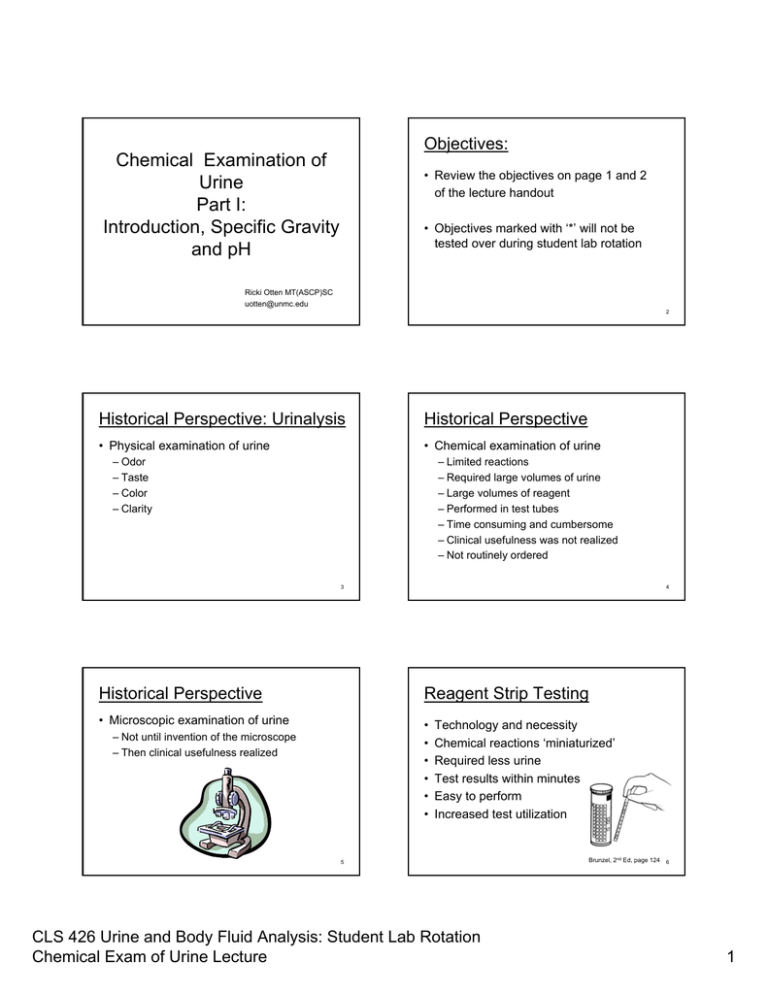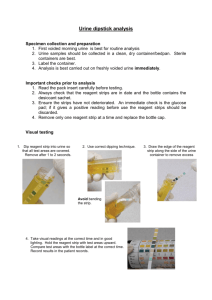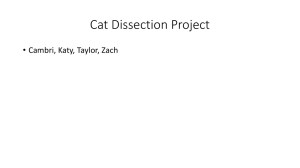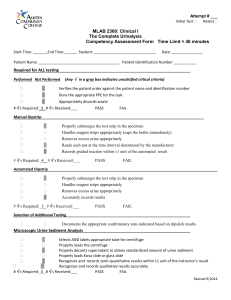Chemical Examination of Urine Part I: Introduction, Specific Gravity
advertisement

Objectives: Chemical Examination of Urine Part I: Introduction, Specific Gravity and pH • Review the objectives on page 1 and 2 of the lecture handout • Objectives marked with ‘*’ will not be tested over during student lab rotation Ricki Otten MT(ASCP)SC uotten@unmc.edu 2 Historical Perspective: Urinalysis Historical Perspective • Physical examination of urine • Chemical examination of urine – Odor – Taste – Color – Clarity – Limited reactions – Required large volumes of urine – Large volumes of reagent – Performed in test tubes – Time consuming and cumbersome – Clinical usefulness was not realized – Not routinely ordered 3 4 Historical Perspective Reagent Strip Testing • Microscopic examination of urine • • • • • • – Not until invention of the microscope – Then clinical usefulness realized Technology and necessity Chemical reactions ‘miniaturized’ Required less urine Test results within minutes Easy to perform Increased test utilization 5 CLS 426 Urine and Body Fluid Analysis: Student Lab Rotation Chemical Exam of Urine Lecture Brunzel, 2nd Ed, page 124 6 1 Reagent Strip Testing Reagent Strip Testing • Ideal qualitative screening tool • Chemically impregnated absorbent pads attached to an inert plastic strip – Sensitive: Low concentration of substances Negative result = normal • Each pad is a specific chemical reaction that takes place upon contact with urine – Specific: Reacts with only one substance False negative and false positive – Cost effective: Relatively inexpensive tool that provides information about the health status of the patient 7 • Chemical reaction causes the color of the pad to change • Color compared to a color chart for interpretation8 Reagent Strip Testing Reagent Strip Testing • Qualitative or semi-quantitative results • Principle of chemical reactions – Concentration units (mg/dl) – Negative, small, moderate large – Negative, 1+, 2+, 3+, 4+ – False negative reactions – False positive reactions – Color interferences • Timing of chemical reactions is CRITICAL • Alternative testing: used to confirm results that you may think are invalid due to – Shortest time requirement on one end of strip: 30 sec – Longest time requirement on the other: 2 min – Interfering substance – Color interference (called color masking) 9 Care and Storage (pg 4) 10 Confirmatory Testing • Defined: Alternative testing establishes the correctness or accuracy of another procedure Reading assignment: Textbook, chapter 7 Page 124-130 • Often used when urine is highly pigmented or when results are suspected to be incorrect Confirmatory Testing (pg 6) – Bilirubin reagent strip Æ ictotest 11 CLS 426 Urine and Body Fluid Analysis: Student Lab Rotation Chemical Exam of Urine Lecture 12 2 Confirmatory Testing Differ in Specificity • Characteristics: • Clinitest reacts with all reducing substances – Differ in sensitivity • Ictotest vs Bilirubin reagent strip – Differ in specificity • SSA vs Protein reagent strip • Clinitest vs Glucose reagent strip Ideally want all 3 • Glucose reagent strip reacts with only one reducing substance: glucose – Differ in methodology/reaction 13 Specific Gravity: Purpose 10 reagent strip tests – – – – – – – – – – Specific gravity pH Protein Glucose Ketones Blood Bilirubin Urobilinogen Nitrite Leukocyte Esterase 14 • • • • • • Evaluates the concentrating and diluting ability of the kidney Purpose of the test What is normal What is abnormal Reaction Causes of invalid results – Density is related to the amount of substances (solutes) in solution – Increased density ~ increased solute in solution ~ hypertonic urine ~ concentrated urine – Decreased density ~ decreased solute in solution ~ hypotonic urine ~ dilute urine 15 16 Specific Gravity: Terms Specific Gravity: Normal • Isosthenuria • Normal: 1.002 – 1.035 – Fixed at 1.010 – Renal tubules lost absorption and secreting capability • Majority of urines: 1.010 – 1.025 • Hypersthenuria – Increased specific gravity – Concentrated urine • Physiologically impossible: 1.000 >1.040 • Hyposthenuria • Dependent upon hydration status Sensitivity issues: Pregnancy testing Urinary tract infection – Decreased specific gravity – Dilute urine 17 CLS 426 Urine and Body Fluid Analysis: Student Lab Rotation Chemical Exam of Urine Lecture 18 3 Specific Gravity: Reaction Specific Gravity: Methods • Based on a change in the pKa of a polyelectrolyte on the reagent pad • Methods of measurement – Reagent strip test: indicates ionic solutes – Refractometer: indicates amount of total solutes • Two functions of the kidney – Maintain water balance – Maintain electrolyte homeostasis Performed by renal tubules through concentrating and diluting; reabsorbing and secreting water and electrolytes (ionic) • Increased ions in solution causes the polyelectrolyte on the pad to produce free H+ • Free H+ cause a change in pH on the reagent pad • Change in pH: bromthymol blue indicator 19 Specific Gravity: Reaction 20 Specific Gravity • Sensitivity: 1.000 • Specificity: detects only ionic substances – Radiographic dye – Mannitol – Glucose Does not interfere 21 22 pH: Purpose pH: Normal • Kidneys regulate body’s acid-base balance by selective handling of H+ and HCO3- • Normal: ranges from 4.5 – 8.0 – Urine pH reflects acid-base status of body • First morning void: acidic • Treatment protocol may require urine pH be maintained at a specific pH • Physiologically impossible: <4.5 >8.0 (Aids in identification of crystals (microscope)) 1. Urine not handled properly 2. Old urine 3. Treatment induced 23 CLS 426 Urine and Body Fluid Analysis: Student Lab Rotation Chemical Exam of Urine Lecture 24 4 pH: Interpretation pH: Abnormal • Made in conjunction with • Acid – – – – – Acid-base status – Renal function – Presence of infection in urinary tract – Diet: high protein, low protein – Medications – Age of urine sample • Alkaline Respiratory acidosis High protein diet Starvation UTI – – – – Respiratory alkalosis Vegetarian diet Renal tubular acidosis UTI 25 pH: Reaction pH: • Double indicator system – Methyl red – Bromthymol blue 26 • Invalid test results due to: – Improper handling of urine sample Needed to measure the wide pH range: acid to alkaline – Contamination of urine vessel prior to collection H+ • Amount of free influences acidity of urine and cause pH indicator to change color – ‘Run-over’ phenomenon 27 CLS 426 Urine and Body Fluid Analysis: Student Lab Rotation Chemical Exam of Urine Lecture 28 5







